Using a Digital Scale for Weighing and Making Cuts
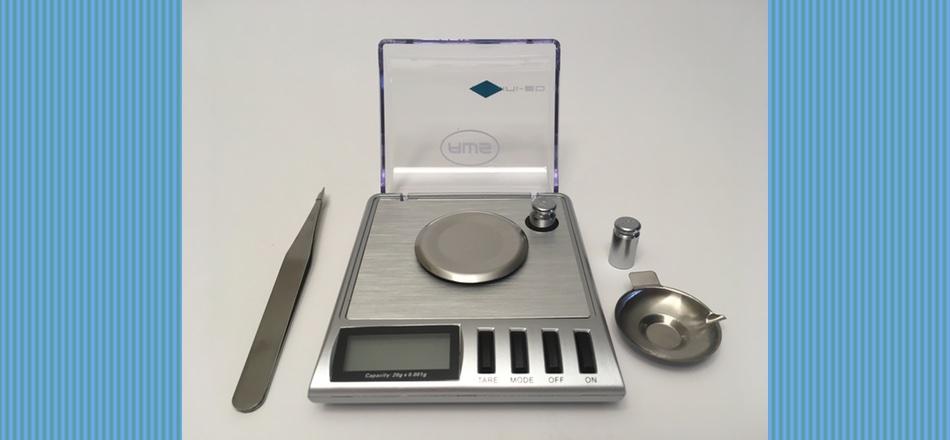
Though different models will vary, generally speaking, a digital scale is made up of a scale platform, weighing tray, display, keypad, and tare button.
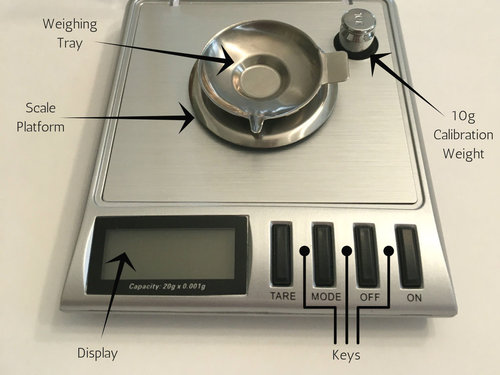
1. Calibrate the scale according to the manufacturer’s instructions. If a calibration weight doesn’t come with the scale, a small weight calibrator can be purchased separately. It’s also reportedly possible to use new, unworn coins for weight calibration. Instructions for “how to calibrate a digital scale” are widely available online for different types of scales, and the U.S. Mint provides the weight specifications for its coins on its website.
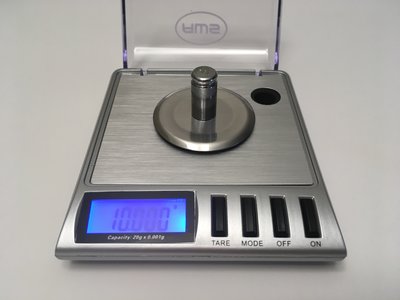
4. After calibrating the scale, “zero out” the measuring bowl or tray by placing it on the scale and using the tare function.
5.a. If using tablets, place one tablet, intact, in the measuring bowl.
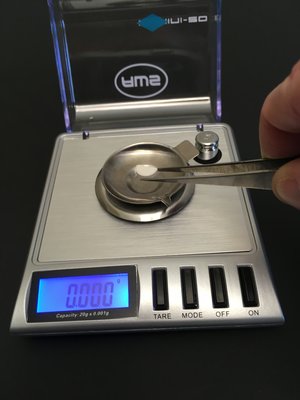
5.b. If using capsules, take one capsule and open it up over the measuring bowl or tray by holding each end between a thumb and forefinger and twisting apart at the middle. Empty out the powder or beads of the capsule into the bowl or tray, and place the capsule halves aside. (The goal is to weigh only what’s inside the capsule, not including the capsule halves themselves.)
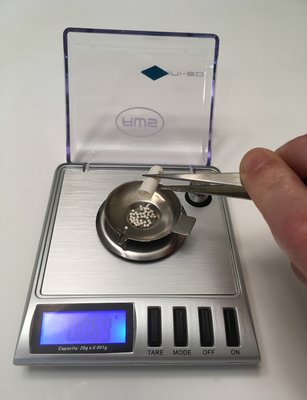
6. Do not allow the scale to be disturbed by any pressure or motion. Even moving air can disrupt the accuracy of the reading at this level of precision. Wait until the numbers on the digital display stop changing, and then write down the measured weight.
7. Do the calculations required to determine the amount to cut from the weight based on the planned taper rate and schedule. (See "Doing Calculations for a Taper".)
8. Consult "Understanding the Limits of a Digital Scale's Accuracy" to determine if the single capsule or tablet is too light to be accurately measured by the scale or if the planned cut is too small to be accurately measured.
9. If diluting the drug with a pharmaceutical-grade powder filler, measure and mix in the appropriate amount.
10. Carefully remove the calculated amount of the cut. Since the weight of individual tablets, powder or beads can vary even within the same pill bottle, people in the lay withdrawal community tend to weigh 4-5 tablets or the contents of 4-5 capsules separately, calculate their average weight, and then use this average as the basis for their measurements and cuts. Many laypeople recalculate this average with each new prescription bottle, and especially after any changes in dosage or manufacturing source of the drugs.
11. Using a small spoon, scoop, tweezers, or tray, transfer the remaining drug contents into a new capsule for consumption. It is also possible to mix the contents in water and consume.
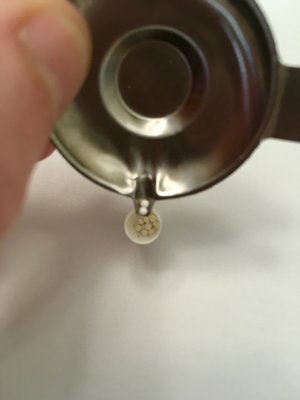
12. Clean the scale according to the manufacturer’s instructions.

Laypeople in the withdrawal community commonly suggest these additional tips to one another:
- Never confuse the measured weight in mg with a drug’s active ingredient amount in mg. The weight of a tablet or of the contents of a capsule will include fillers and other ingredients, active drug and, in the case of beaded capsules, bead coating. Therefore, the measured weight will be more than the tablet or capsule’s amount of actual, active drug dose. For example, laypeople have reported that a 2mg tablet of diazepam can weigh 152mg, a 0.5mg tablet of clonazepam can weigh 168mg, and a 30mg beaded capsule of duloxetine (including capsule halves) can weigh 315mg.
- Always place the scale on a level surface during measurements.
- Minimize vibrations as well as movements of air when using the scale: shut nearby windows, turn off fans, and try not to disturb the scale with breathing (some people wear a painter’s mask or medical mask).
- Some people have reported that the presence of static electrical charges nearby can affect their scale’s measurements, especially as the amounts being weighed become smaller. Simple tips for removing or “neutralizing” static charges around the home are available online.
In this section
- Step 10- Get Informed About Your Psychiatric Drug
- Step 11- Ensuring that a Drug is Relatively ‘Taper-friendly’
- Step 12- Interactions, Reactions and Sensitivities
- Step 13- Taper Rates
- Step 14- Taper Schedules
- Step 15- Taper Methods
- Step 16- Preparatory Decisions
- Step 17- Gather the Gear
-
Step 18- Essential Skills
- Counting and Making Cuts with Beads
- Diluting Powder When Using a Digital Scale
- Understanding the Limits of a Digital Scale's Accuracy
- Using an Adapter Cap
- Using a Digital Scale for Weighing and Making Cuts
- Using a Mortar and Pestle for Pulverizing Tablets
- Using Syringes
- Doing Calculations for a Taper
- Special Tips for Calculations and Liquids
- Step 19- Setting Up a Taper Journal
- Step 20- Implementing a Taper
TWP’s Companion Guide to Psychiatric Drug Withdrawal Part 2: Taper